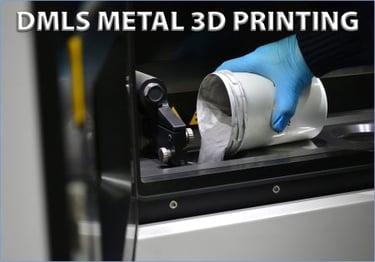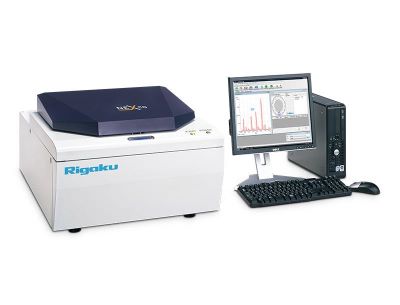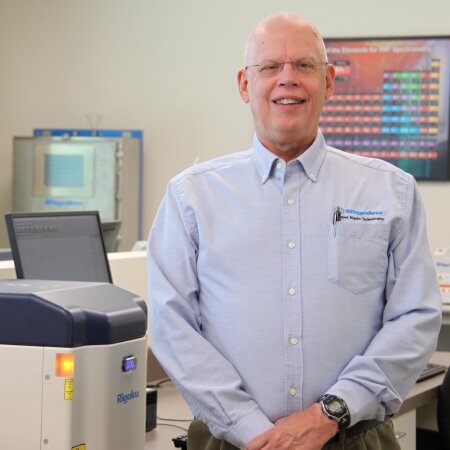Application Note EDXRF1884
Scope
The analysis of alloy powders used for 3D printing is demonstrated.
Background
 DMLS (Direct Metal Laser Sintering) is an industrial metal 3D printing method that fuses layers of fine metal powder particles, creating a metal part layer by layer. Metal 3D printing techniques are ideal for manufacturing complex metal shapes that can be expensive or impossible to produce using traditional manufacturing methods. Metal 3D printed parts are typically stronger and denser than those made by traditional casting. The DMLS process is used for prototyping metals parts and low volume manufacturing, eliminating expensive and time-consuming tooling. When mixing various metal alloy powders, it is important to monitor the elemental compositions of the raw materials and powder mixtures to ensure proper alloy balances for the parts being produced. Applied Rigaku Technologies offers the Rigaku NEX CG EDXRF spectrometer for fast and simple analysis of metal alloy powders used in metal 3D printing.
DMLS (Direct Metal Laser Sintering) is an industrial metal 3D printing method that fuses layers of fine metal powder particles, creating a metal part layer by layer. Metal 3D printing techniques are ideal for manufacturing complex metal shapes that can be expensive or impossible to produce using traditional manufacturing methods. Metal 3D printed parts are typically stronger and denser than those made by traditional casting. The DMLS process is used for prototyping metals parts and low volume manufacturing, eliminating expensive and time-consuming tooling. When mixing various metal alloy powders, it is important to monitor the elemental compositions of the raw materials and powder mixtures to ensure proper alloy balances for the parts being produced. Applied Rigaku Technologies offers the Rigaku NEX CG EDXRF spectrometer for fast and simple analysis of metal alloy powders used in metal 3D printing.

Model NEX CG
Analytical results
| Sample ID: Al-Si-Mg Units: Mass% |
||
| Component | Result | Stat. error |
| Mg | 0.492 | 0.0138 |
| Al | 88.97 | Balance |
| Si | 10.25 | 0.0146 |
| P | ND* | 0.0003 |
| S | 0.0029 | 0.0001 |
| Cl | 0.0008 | 0.0001 |
| Ti | 0.0071 | 0.0004 |
| V | 0.0107 | 0.0004 |
| Cr | 0.0015 | 0.0002 |
| Mn | 0.0029 | 0.0001 |
| Fe | 0.236 | 0.0009 |
| Co | ND* | 0.0001 |
| Ni | 0.0051 | 0.0002 |
| Cu | 0.0069 | 0.0002 |
| Zn | 0.0062 | 0.0001 |
| Ga | 0.0096 | 0.0002 |
| Y | ND* | <0.0001 |
| Nb | ND* | 0.0002 |
| Mo | ND* | 0.0008 |
| Sn | 0.0014 | 0.0004 |
| Pb | 0.0013 | 0.0001 |
| Sample ID: Ti-Al-V Units: Mass% |
||
| Component | Result | Stat. error |
| Mg | ND* | 0.0048 |
| Al | 4.32 | 0.0090 |
| Si | 0.0498 | 0.0007 |
| P | 0.0146 | 0.0002 |
| S | 0.0067 | 0.0001 |
| Cl | 0.0027 | 0.0001 |
| Ti | 91.22 | 0.1022 |
| V | 4.18 | 0.0197 |
| Cr | ND* | 0.0046 |
| Mn | ND* | 0.0005 |
| Fe | 0.200 | 0.0025 |
| Co | ND* | 0.0005 |
| Ni | 0.0073 | 0.0005 |
| Cu | 0.0029 | 0.0003 |
| Zn | ND* | 0.0002 |
| Ga | ND* | 0.0004 |
| Y | ND* | 0.0001 |
| Nb | ND* | 0.0011 |
| Mo | ND* | 0.0033 |
| Sample ID: PHSS Units: Mass% |
||
| Component | Result | Stat. error |
| Mg | ND* | 0.0053 |
| Al | 0.0698 | 0.0014 |
| Si | 0.578 | 0.0025 |
| P | 0.0161 | 0.0003 |
| S | 0.0181 | 0.0003 |
| Cl | 0.0144 | 0.0001 |
| Ti | ND* | 0.0029 |
| V | ND* | 0.0017 |
| Cr | 16.36 | 0.0287 |
| Mn | 0.131 | 0.0103 |
| Fe | 74.42 | 0.0539 |
| Co | 0.237 | 0.0097 |
| Ni | 4.20 | 0.0172 |
| Cu | 3.57 | 0.0140 |
| Zn | ND* | 0.0010 |
| Ga | ND* | 0.0005 |
| Y | ND* | 0.0002 |
| Nb | 0.382 | 0.0109 |
| Mo | ND* | 0.0079 |
| Sample ID: 316LSS Units: Mass% |
||
| Component | Result | Stat. error |
| Mg | ND* | 0.0050 |
| Al | 0.0617 | 0.0015 |
| Si | 0.582 | 0.0026 |
| P | 0.0042 | 0.0005 |
| S | ND* | 0.0013 |
| Cl | ND* | 0.0001 |
| Ti | ND* | 0.0028 |
| V | ND* | 0.0020 |
| Cr | 18.14 | 0.0293 |
| Mn | 1.17 | 0.0119 |
| Fe | 63.59 | 0.0489 |
| Co | 0.254 | 0.0088 |
| Ni | 13.38 | 0.0270 |
| Cu | ND* | 0.0029 |
| Zn | ND* | 0.0006 |
| Ga | ND* | 0.0004 |
| Y | ND* | 0.0002 |
| Nb | ND* | 0.0098 |
| Mo | 2.81 | 0.0653 |
| Sample ID: INC625 Units: Mass% |
||
| Component | Result | Stat. error |
| Mg | ND* | 0.0057 |
| Al | 0.134 | 0.0025 |
| Si | 0.0533 | 0.0011 |
| P | ND* | 0.0010 |
| S | ND* | 0.0027 |
| Cl | ND* | 0.0003 |
| Ti | 0.125 | 0.0022 |
| V | ND* | 0.0010 |
| Cr | 19.19 | 0.0181 |
| Mn | 0.0923 | 0.0048 |
| Fe | 0.0511 | 0.0008 |
| Co | 0.0326 | 0.0006 |
| Ni | 65.89 | 0.0351 |
| Cu | 0.184 | 0.0044 |
| Zn | ND* | 0.0008 |
| Ga | ND* | 0.0006 |
| Y | 0.0078 | 0.0011 |
| Nb | 4.32 | 0.0371 |
| Mo | 9.92 | 0.1277 |
| Sample ID: INC718 Units: Mass% |
||
| Component | Result | Stat.error |
| Mg | ND* | 0.0057 |
| Al | 0.256 | 0.0030 |
| Si | 0.0798 | 0.0012 |
| P | ND* | 0.0009 |
| S | ND* | 0.0018 |
| Cl | ND* | 0.0002 |
| Ti | 0.901 | 0.0065 |
| V | 0.0158 | 0.0023 |
| Cr | 17.61 | 0.0212 |
| Mn | 0.177 | 0.0062 |
| Fe | 16.88 | 0.0181 |
| Co | 0.242 | 0.0034 |
| Ni | 53.07 | 0.0347 |
| Cu | 0.365 | 0.0043 |
| Zn | ND* | 0.0008 |
| Ga | ND* | 0.0006 |
| Y | ND* | 0.0007 |
| Nb | 6.68 | 0.0465 |
| Mo | 3.71 | 0.0825 |
* ND means the component was not detected
Discussion
Standardless semi-quant Fundamental Parameters (FP) is used for the analysis using the NEX CG Pellet template. For metal alloy powders, no balance component is required since metals contain only trace or no organic elements, and do not affect the measurement of the measureable elements Na-U. Rigaku RPF-SQX FP uses advanced theory to calculate concentration results without the need for assayed reference materials. FP results can be further optimized and made fully quantitative with the use of a Matching Library. The intuitive and simple Rigaku software allows users to easily create a Matching Library to model their exact powders. One or more samples are assayed by a referee technique such as ICP and are considered type standards. The type standards are measured and registered in the library, which then adjusts the theoretical intensities and matches them to measured intensities of the known standards and the referee assay values, providing a fully quantitative optimized result.
Conclusion
This study illustrates how the NEX CG analyzer with secondary targets and the Rigaku RPF-SQX FP program yields excellent sensitivity and results for the elements of interest. The NEX CG offers the flexibility to reliably measure elements from Na to U and this versatility will allow the analyzer to adapt to the varying sample compositions and potential contaminant that may be encountered in the metal powders. The Rigaku NEX CG, with its high performance and simple yet advanced software, provides an easy-to-use and valuable tool for the metal 3D printing industry to ensure proper alloy mixtures and high quality metal parts.

